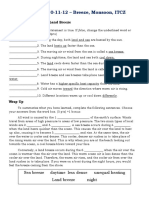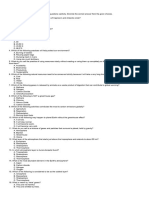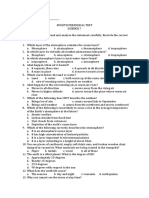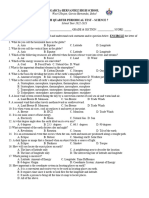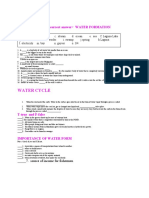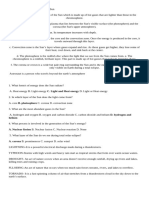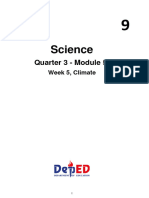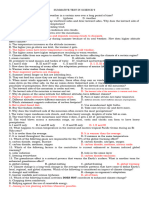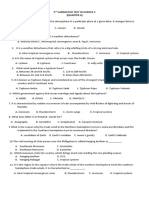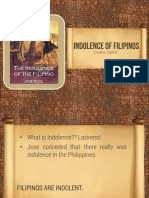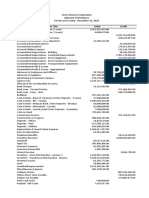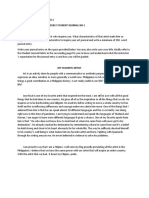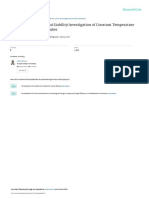0 ratings0% found this document useful (0 votes)
41 viewsOslob District Secondary Summative Assessment - 2 (Fourth Quarter) Science - 7
Oslob District Secondary Summative Assessment - 2 (Fourth Quarter) Science - 7
Uploaded by
Judith DurensThis document is a science assessment for 7th grade students covering topics about the atmosphere and weather. It contains 20 multiple choice questions testing students' knowledge of the layers of the atmosphere, temperature changes with altitude, greenhouse effect, monsoons, trade winds, and the Inter-Tropical Convergence Zone (ITCZ). The questions cover definitions, properties, and interactions between different components of the atmosphere and how they influence weather patterns.
Copyright:
© All Rights Reserved
Available Formats
Download as DOCX, PDF, TXT or read online from Scribd
Oslob District Secondary Summative Assessment - 2 (Fourth Quarter) Science - 7
Oslob District Secondary Summative Assessment - 2 (Fourth Quarter) Science - 7
Uploaded by
Judith Durens0 ratings0% found this document useful (0 votes)
41 views2 pagesThis document is a science assessment for 7th grade students covering topics about the atmosphere and weather. It contains 20 multiple choice questions testing students' knowledge of the layers of the atmosphere, temperature changes with altitude, greenhouse effect, monsoons, trade winds, and the Inter-Tropical Convergence Zone (ITCZ). The questions cover definitions, properties, and interactions between different components of the atmosphere and how they influence weather patterns.
Original Title
Q4-Sum2-Gr7
Copyright
© © All Rights Reserved
Available Formats
DOCX, PDF, TXT or read online from Scribd
Share this document
Did you find this document useful?
Is this content inappropriate?
This document is a science assessment for 7th grade students covering topics about the atmosphere and weather. It contains 20 multiple choice questions testing students' knowledge of the layers of the atmosphere, temperature changes with altitude, greenhouse effect, monsoons, trade winds, and the Inter-Tropical Convergence Zone (ITCZ). The questions cover definitions, properties, and interactions between different components of the atmosphere and how they influence weather patterns.
Copyright:
© All Rights Reserved
Available Formats
Download as DOCX, PDF, TXT or read online from Scribd
Download as docx, pdf, or txt
0 ratings0% found this document useful (0 votes)
41 views2 pagesOslob District Secondary Summative Assessment - 2 (Fourth Quarter) Science - 7
Oslob District Secondary Summative Assessment - 2 (Fourth Quarter) Science - 7
Uploaded by
Judith DurensThis document is a science assessment for 7th grade students covering topics about the atmosphere and weather. It contains 20 multiple choice questions testing students' knowledge of the layers of the atmosphere, temperature changes with altitude, greenhouse effect, monsoons, trade winds, and the Inter-Tropical Convergence Zone (ITCZ). The questions cover definitions, properties, and interactions between different components of the atmosphere and how they influence weather patterns.
Copyright:
© All Rights Reserved
Available Formats
Download as DOCX, PDF, TXT or read online from Scribd
Download as docx, pdf, or txt
You are on page 1of 2
OSLOB DISTRICT SECONDARY
Summative Assessment – 2 (Fourth Quarter)
SCIENCE - 7
SY 2020 – 2021
Name __________________________Yr. & Sec. _______________Date _________Score_________
TEST I. DIRECTIONS: Fill in the missing word/s. Choose your answer/s from the given
choices and write it on the blank provided for.
1. The Earth is surrounded by a blanket of air called ______________ ( the atmosphere,
oxygen)
2. The atmosphere is a mixture of ___________. ( gases, rocks)
3. About three fourths of the atmosphere is _____________( oxygen, nitrogen)
4. The layer of atmosphere closest to Earth is the __________( troposphere, carbon dioxide)
5. Ozone keeps most of the sun’s harmful ___________from reaching the Earth.
( radiation, sound waves)
B. Multiple Choice. Encircle the letter of the correct answer.
6. This is the layer where meteors, or shooting stars burns up.
A. Troposphere C. Stratosphere
B. Mesosphere D. Thermosphere
7. The layers of the atmosphere are separated according to this change.
A. Altitude B. Temperature C. Elevation D. distance from the Sun
8. As you get higher off the ground what happens to air temperature?
A. It increases B. It stays the same C. It decreases D. all of the above
9. Which layer of the atmosphere contains life forms and weather?
A. Troposphere B. Stratosphere C. Mesosphere D. Thermosphere
10. In a typical troposphere, air temperature decreases with height at the
following rate:
A) 2.5 degree C per one kilometer
B) 6.5 degree C per one kilometer
C) 10.5 degree C per one kilometer
11. Earth’s atmosphere traps energy from the sun, which
A. Allows water to exist as a liquid C. Allows solar radiation to penetrate to the surface
B. Allows ozone to form freely D. Causes meteors to burn up
12. A cool and dry monsoonal wind that occurs from October to late March is ___
A. Southwest Monsoon C. Northeast Monsoon
B. Land Breeze D. Sea Breeze
13. What kind of breeze blows during daytime?
A. Land breeze B. Sea breeze C. ITCZ D. None of the above
14. Cooler air always ___ A. Stay where it’s at B. sink C. rises D. Moves in all
directions
15. Warmer air always ___ A. Stay where it’s at B. sink C. rises D. Moves in all
directions
16. How do the heating and cooling rates of land and water compare?
A. Water heats and cools faster.
B. Land heats faster, but water cools faster
C. Land heats and cools faster
D. Land and water heat and cool at the same rate
17. Where do monsoons take place?
A . An ice cap B. Tropical climate
C. Subtropical climate D. Inter-tropical climate
18. Why is the ITCZ a prevailing weather phenomenon in our country?
A. Because of the vast expanse of water at the equatorial region,
the ITCZ brings plenty of rain.
B. The ITCZ moves farther north or farther south of the equator where
temperature goes higher.
C. The doldrums are formed by the oppositely charging trade
winds from 30°N and 30°S
D. The Philippines is located at the equatorial region where
Northeast and Southeast Trade Winds meet
19. What is FALSE about Inter-Tropical Convergence Zone (ITCZ)?
A. It results in thunderstorms
B. It occurs in the Philippines all year round.
C. It is a place where winds in the tropics meet, rise and form clouds
D. It occurs in countries near the equator.
20. In what direction do winds blow?
A. from the northeast to the southwest
B. from high pressure areas to low pressure areas
C. from the low-pressure areas to high pressure areas
D. from the southwest to the northeast
You might also like
- Grade 7 4th Quarter ExamDocument6 pagesGrade 7 4th Quarter ExamSher Sherwin93% (15)
- Basher Basics: Weather: Whipping up a storm!From EverandBasher Basics: Weather: Whipping up a storm!Rating: 4.5 out of 5 stars4.5/5 (2)
- Barack Obama, David Axelrod and Scott Corwon - Climate Policy by PollDocument2 pagesBarack Obama, David Axelrod and Scott Corwon - Climate Policy by PollClimateTruth100% (10)
- g7 Science 4th Quarter Midterm Exam 107 CopiesDocument2 pagesg7 Science 4th Quarter Midterm Exam 107 CopiesrjrcimafrancaNo ratings yet
- Science Test - Weather and ClimateDocument4 pagesScience Test - Weather and Climatekbarrie2012No ratings yet
- Grade 7Document6 pagesGrade 7norsida b. padoNo ratings yet
- Session 5Document4 pagesSession 5RainbowNo ratings yet
- Science 7Document7 pagesScience 7Trisha Camille MacarioNo ratings yet
- Summative Test 2 Science 7 (4 Quarter)Document2 pagesSummative Test 2 Science 7 (4 Quarter)Alvin GultiaNo ratings yet
- Science 7 Summative Test 4thmod.2Document3 pagesScience 7 Summative Test 4thmod.2Marian Anion-Gaurano100% (1)
- Summative Test 4th 4Document3 pagesSummative Test 4th 4Jerome CasillaNo ratings yet
- D.Prevailing Winds Provides Winds That Gives Amount of Wet Air in A RegionDocument4 pagesD.Prevailing Winds Provides Winds That Gives Amount of Wet Air in A RegionCharo May NaiganNo ratings yet
- Science 7 Assessment 4.3 Multiple ChoiceDocument2 pagesScience 7 Assessment 4.3 Multiple ChoiceMjnicole MartejaNo ratings yet
- Science 7 2nd Summative m3-m4Document2 pagesScience 7 2nd Summative m3-m4Melannie MagalongNo ratings yet
- Mock Test No AanswersDocument3 pagesMock Test No AanswersromeroroakylarNo ratings yet
- Module 9 10 11 12 Breeze Monsoons and ITCZDocument7 pagesModule 9 10 11 12 Breeze Monsoons and ITCZkali dizonNo ratings yet
- SCIENCE 4th QUARTER - REVIEWDocument3 pagesSCIENCE 4th QUARTER - REVIEWcarlkevinval.ybanez029No ratings yet
- Summative Test 2 Earth and SpaceDocument4 pagesSummative Test 2 Earth and SpaceNoemi SalacsacanNo ratings yet
- 4Q Science G7Document5 pages4Q Science G7Kimmy Grace TañoNo ratings yet
- Science 7 3rd Summative m5-m6Document3 pagesScience 7 3rd Summative m5-m6Melannie MagalongNo ratings yet
- Science 7Document3 pagesScience 7CECELIA OMAPASNo ratings yet
- 11111Document4 pages11111Jezha Mae VertudazoNo ratings yet
- 4Q Sci 7 PTDocument4 pages4Q Sci 7 PTmay flor obonNo ratings yet
- 4Q Science 7 PTDocument4 pages4Q Science 7 PTGeorge Claro BayerNo ratings yet
- Pre Test - Q4Document4 pagesPre Test - Q4Jon-Jon ManlapasNo ratings yet
- CH 2Document12 pagesCH 213jabbasNo ratings yet
- 4Q ScienceDocument4 pages4Q ScienceAnton RimbsNo ratings yet
- Sase Booster 2024 Science Module 1Document4 pagesSase Booster 2024 Science Module 1Teresita HeyasaNo ratings yet
- ASSESSMENT IN SCIENCE 9 WK 5&6Document2 pagesASSESSMENT IN SCIENCE 9 WK 5&6Jaybie TejadaNo ratings yet
- Grade 7 Q4Document3 pagesGrade 7 Q4JosephineNo ratings yet
- Summative Test in Science 9Document2 pagesSummative Test in Science 9Clee Ann BalofiñosNo ratings yet
- 4th Quarter Science 7Document5 pages4th Quarter Science 7diannemaereyes98No ratings yet
- Grade 7 ScienceDocument2 pagesGrade 7 ScienceJohn Carter83% (6)
- Q4 SCIENCE 7 Periodical TestDocument4 pagesQ4 SCIENCE 7 Periodical TestOclarit Joseph CarlNo ratings yet
- 4TH Exam - Sci 7Document4 pages4TH Exam - Sci 7Julius Magaru Raquel100% (1)
- Quiz 2Document4 pagesQuiz 2Roman Aries SampoleoNo ratings yet
- Grade 3-6 Weather, Water, AirDocument8 pagesGrade 3-6 Weather, Water, AirMis GloriaNo ratings yet
- Quiz About Climate grADE 9Document22 pagesQuiz About Climate grADE 9vengie arellano67% (3)
- Other Words To Be Defined IncludesDocument56 pagesOther Words To Be Defined IncludesLeaNo ratings yet
- Las Science 7 Q4 W3Document7 pagesLas Science 7 Q4 W3Juliet GalletesNo ratings yet
- Activity AtmosphereDocument3 pagesActivity AtmosphereRose Belle A. GarciaNo ratings yet
- Science 7 4th Peridic TestDocument5 pagesScience 7 4th Peridic TestBettina SanchezNo ratings yet
- 10go Up Science SummativeDocument9 pages10go Up Science SummativeMark Anthony Telan PitogoNo ratings yet
- Summative Test in Science 7Document3 pagesSummative Test in Science 7MICAH NORADANo ratings yet
- Q4 SCIENCE 7 Reviewer TestDocument2 pagesQ4 SCIENCE 7 Reviewer TestOclarit Joseph CarlNo ratings yet
- FEB8Document75 pagesFEB8Anne Dominique VenturaNo ratings yet
- Assessment Climate ChangeDocument3 pagesAssessment Climate ChangeIN-IN JALNo ratings yet
- Science 7Document6 pagesScience 7gladys.tuvieronNo ratings yet
- SCI 9 Q3 Module 5 WEEK 5Document19 pagesSCI 9 Q3 Module 5 WEEK 5shimuraririkkuNo ratings yet
- Campbell BiologyDocument6 pagesCampbell Biologydtt852168No ratings yet
- Science 7-Q4 - EXAMDocument3 pagesScience 7-Q4 - EXAMnobhegrace.pinoNo ratings yet
- Summative Test in Science 9Document2 pagesSummative Test in Science 9analyn.reyes003No ratings yet
- Earth Science TestDocument3 pagesEarth Science TestRenz Ortega100% (1)
- Semi Finals in Grade 7 ScienceDocument6 pagesSemi Finals in Grade 7 ScienceMaryGrace Cruz-MatienzoNo ratings yet
- Science 2nd QDocument2 pagesScience 2nd QLiezel E. GutierrezNo ratings yet
- Summative TestDocument2 pagesSummative TestJaybie TejadaNo ratings yet
- 4th Grading ScienceDocument6 pages4th Grading Scienceann reyesNo ratings yet
- Final Examination g7Document6 pagesFinal Examination g7Lorena Dizon100% (1)
- FOURTH QUARTER Summative Test - 23-24Document2 pagesFOURTH QUARTER Summative Test - 23-24Cristy VillamorNo ratings yet
- Test 9-16-10 Corrections Needed 9-13-10Document3 pagesTest 9-16-10 Corrections Needed 9-13-10Jessica IsemanNo ratings yet
- Questions and Answers about: Planet EarthFrom EverandQuestions and Answers about: Planet EarthRating: 3 out of 5 stars3/5 (1)
- Assignment No. 2Document1 pageAssignment No. 2Judith DurensNo ratings yet
- Assignment No. 3Document1 pageAssignment No. 3Judith DurensNo ratings yet
- Indolence of FilipinosDocument11 pagesIndolence of FilipinosJudith DurensNo ratings yet
- The Women of RizalDocument25 pagesThe Women of RizalJudith DurensNo ratings yet
- Rizal's Second Travel AbroadDocument19 pagesRizal's Second Travel AbroadJudith DurensNo ratings yet
- GROUP 6 KoreaDocument6 pagesGROUP 6 KoreaJudith DurensNo ratings yet
- Factors Affecting The Choice of Buying Korean Cosmetics: Management Science Letters January 2020Document11 pagesFactors Affecting The Choice of Buying Korean Cosmetics: Management Science Letters January 2020Judith DurensNo ratings yet
- A1 FS PreparationDocument1 pageA1 FS PreparationJudith DurensNo ratings yet
- Seven Heaven Corporation Adjusted Trial Balance For The Year Ended - December 31, 2019Document3 pagesSeven Heaven Corporation Adjusted Trial Balance For The Year Ended - December 31, 2019Judith DurensNo ratings yet
- RR 129 001Document36 pagesRR 129 001Judith DurensNo ratings yet
- Durens CVPDIYDocument1 pageDurens CVPDIYJudith DurensNo ratings yet
- Mae AnnDocument11 pagesMae AnnJudith DurensNo ratings yet
- ReEd 2Document3 pagesReEd 2Judith DurensNo ratings yet
- Research and DevelopmentDocument2 pagesResearch and DevelopmentJudith DurensNo ratings yet
- IDP by Shaahid (1) GFDFDDDDocument38 pagesIDP by Shaahid (1) GFDFDDDShaik ShaahidNo ratings yet
- HW 9 CH 16Document2 pagesHW 9 CH 16Khalil JennetteNo ratings yet
- Economic Analysis & Policy, Vol. 38 No. 2, September 2008Document26 pagesEconomic Analysis & Policy, Vol. 38 No. 2, September 2008rigratNo ratings yet
- Report WritingDocument7 pagesReport WritingSagar RishiNo ratings yet
- Energy Consumption and Stability Investigation ofDocument12 pagesEnergy Consumption and Stability Investigation ofsandroNo ratings yet
- INGLES 0 90030A - 222: Quiz NavigationDocument4 pagesINGLES 0 90030A - 222: Quiz Navigationrobin4219No ratings yet
- Dian Dwi Kartikasari WetlandDocument25 pagesDian Dwi Kartikasari WetlandDian DwiNo ratings yet
- Intruduction - Fertigation Machines With TalGil - Munters Controler 2023 - PDF - PreviewDocument29 pagesIntruduction - Fertigation Machines With TalGil - Munters Controler 2023 - PDF - PreviewMehdi BassouNo ratings yet
- Limate: Download All Ncert Books Pdfs From WWW - Ncert.OnlineDocument16 pagesLimate: Download All Ncert Books Pdfs From WWW - Ncert.OnlineRRSNo ratings yet
- Dupont Global PV Reliability: 2018 Field AnalysisDocument6 pagesDupont Global PV Reliability: 2018 Field AnalysissanNo ratings yet
- African Geography: Presented by Group 1Document11 pagesAfrican Geography: Presented by Group 1Third FabrosNo ratings yet
- Vision: GeographyDocument19 pagesVision: GeographyKrishna NathNo ratings yet
- Global Warming in New Zealand IELTS Reading PassageDocument16 pagesGlobal Warming in New Zealand IELTS Reading PassageSantosh LamichhaneNo ratings yet
- Geography NotesDocument4 pagesGeography NotesPassw0rdNo ratings yet
- Global Warming and Its Impact On The Productivity Muga SilkwormDocument12 pagesGlobal Warming and Its Impact On The Productivity Muga SilkwormDINAMANI 0inamNo ratings yet
- 2013 Pacific Typhoon SeasonDocument30 pages2013 Pacific Typhoon SeasonpdekraaijNo ratings yet
- Written by Yamin Khan, PHD and Sarah Tilly: NtroductionDocument10 pagesWritten by Yamin Khan, PHD and Sarah Tilly: NtroductionChikezie OnwukweNo ratings yet
- Meteorology - Air MassesDocument23 pagesMeteorology - Air MassesDAAN John MichaelNo ratings yet
- A Study On Regenerative Architecture: February 2019Document14 pagesA Study On Regenerative Architecture: February 2019Nihit SandNo ratings yet
- The Impacts of Climate The Impacts of Climate Change On AgricultureDocument97 pagesThe Impacts of Climate The Impacts of Climate Change On AgricultureikatetaNo ratings yet
- Difference Between Doldrums and Horse Latitudes - Difference BetweenDocument5 pagesDifference Between Doldrums and Horse Latitudes - Difference BetweenMartin BaalNo ratings yet
- LindaMandy Climate Unit PDFDocument30 pagesLindaMandy Climate Unit PDFmichelleNo ratings yet
- DTW.12 InsolationDocument7 pagesDTW.12 InsolationniroopswaradNo ratings yet
- Cartoon AnalysisDocument9 pagesCartoon Analysisamaliaccap201667% (3)
- Kuala Lumpur Monsoon Activity Centre: Malaysian Meteorological Department Ministry of Environment and WaterDocument6 pagesKuala Lumpur Monsoon Activity Centre: Malaysian Meteorological Department Ministry of Environment and WatermaznahNo ratings yet
- G7 Block1 Unit2 Lesson9Document10 pagesG7 Block1 Unit2 Lesson9Mahmoud ElarabyNo ratings yet
- NSTP G10Document14 pagesNSTP G10Jasper Aranez MacasaNo ratings yet
- 1981-2010 Clim Normals (Imd Data)Document890 pages1981-2010 Clim Normals (Imd Data)Aanchal RawalNo ratings yet
- Dissertation ReportDocument32 pagesDissertation ReportSonika PatelNo ratings yet















